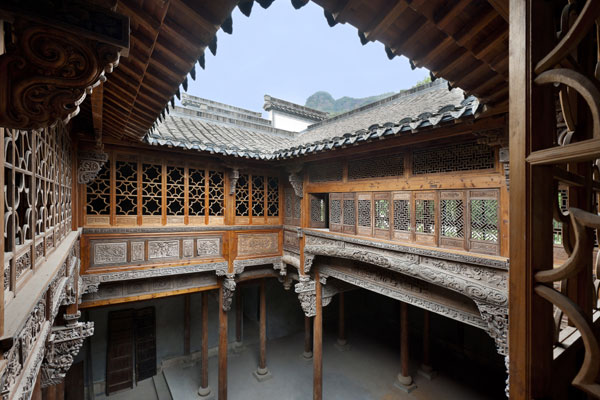A man's passion for ancient Chinese houses drives him to buy many, with the aim of restoring them, he tells Deng Zhangyu.

Some people collect paintings, others, sculptures and antique furniture. But Qin Tongqian does more he buys entire houses, mostly homes built in ancient China.
He doesn't resell them. He is passionate about these old buildings and boasts a collection of more than 400 wooden structures. He restores anything that needs renovation and gives the public a chance to view them once they have been restored to their former glory.
At a warehouse, transformed from a military base in Shaoxing, in eastern China's Zhejiang province, Qin has stored hundreds of rosewood beds, chairs, dining tables, rows of corbels, pillars, windows and all other things required to rebuild the house some more than several centuries old.
It has been six months since his workers started numbering the items, and the process is ongoing. It is just one of the four factory-like warehouses Qin has in Shaoxing and Shanghai.
Qin, owner of a Shanghai-based real estate company, spent his childhood in Shao-xing, a city with many old mansions.
"They are my source of pain and happiness," Qin, 52, says of the ancient houses.
For years, his family and friends thought Qin was "crazy", as he went about buying dilapidated houses, most of which were sold by the original owners, who wanted to live in new houses in the 1990s. Many Chinese moved to apartments back then. The trend of selling old houses had dropped off by 2005, with local governments discouraging the sale of such houses on grounds of protecting cultural heritage.
Among Qin's "collection" are ancestral temples and opera houses.
"Back then, people couldn't understand my passion at all," Qin says, adding that the money from his regular business was invested in buying the ancient houses.
During his travels to rural areas, he sometimes even had to climb mountains to view an ancient temple deep in the valley.
He enjoys being alone and likes to listen to soothing music while making a pot of tea. He describes himself as a strong supporter of traditional Chinese culture. His office and house are both designed in traditional Chinese style.
"It's true that ancient houses are not comfortable enough to live in. But we can transform their inner environment to meet modern living standards instead of dismantling them altogether."
Old Chinese architecture is a mix of philosophy, culture and craftsmanship, especially those built in eastern Anhui and Zhejiang provinces, where many rich people and senior officials lived during the Ming (1368-1644) and Qing (1644-1911) dynasties. They usually placed a lot of value on house designs.
Qin loves the legendary stores, fairy tales and scenes of daily life engraved on pillars, corbels, windows and doors of the antique houses.
"It will take me months to see just the wood carvings of these old buildings. They are hand-carved by craftsmen. Even two pieces with the same pattern have different detail," Qin says.
While buying houses may be easy, restoring them as close to the original as possible is a challenge.
Chinese wooden houses have to have people living in them, or they will quickly decay, says Qin. That's why he is restoring some of them into hotels where people can experience traditional Chinese architecture.
In Zhu Jiajiao, an ancient town in Shanghai's outskirt, Qin re-assembled a traditional opera stage and a mansion that was built at least 600 years ago, while in Shaoxing, he restored dozens of houses to build a hotel.
Both projects were partnered by Indonesian hotel brand Aman Resorts.
It took about four years to restore 100 ancient houses in Qin's possession. He says he will open them to free public viewing in the near future, with an aim to promote a better understanding of traditional Chinese architecture of the Ming and Qing dynasties.
Huang Jian, Qin's friend, says that businessmen from Hong Kong and Singapore were among the first to buy ancient Chinese houses, followed by those from Zhejiang province. Many either resold the houses to other buyers or turned them into paid tourist attractions, Huang says.
Qin says: "I want people to know the treasures passed down from our ancestors, the craftsmanship, the culture and the traditional relationships between family members."
He says many wealthy Chinese of his generation respect traditional Chinese culture, but prefer to live in Western-style houses. However, the young generation gives him hope. They are more interested in their own culture and have the awareness of protection of cultural relics.
"In the youth, I see the future of cultural protection."





